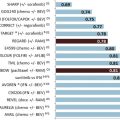Gastric and esophageal tumors have a poor prognosis; approximately 15% of patients are alive at 10 years following diagnosis. Surgical resection plus adjunctive chemotherapy or chemoradiotherapy is curative in approximately 50% of patients with operable disease, but is also associated with significant morbidity. Therefore, accurate preoperative staging is required to spare patients unnecessary toxicity and futile surgery. This review evaluates the sensitivity and specificities of the modalities used to stage patients with gastroesophageal cancer. Staging techniques reviewed include CT, PET, MRI, EUS, and laparoscopy. The article concludes with suggestions on appropriate staging tools according to site and stage of disease.
Key points
- •
Accurately determining tumor stage before the commencement of treatment is vital for ensuring optimal outcomes for patients who will undergo surgical resection for gastroesophageal cancer.
- •
All patients should undergo computerized tomography in the first instance to establish TNM stage, and PET should be used to detect occult metastases in patients with >T1/N1 or T2 tumors.
- •
For gastric cancers and distal esophageal cancers being considered for curative resection, laparoscopy ± peritoneal lavage should be performed.
Introduction
Gastric and esophageal cancers (OGCs) represent the fourth and seventh most common malignancies worldwide, with an estimated 631,300 and 323,000 new cases globally in 2012. The prognosis of patients diagnosed with esophagogastric cancer is notoriously poor, with modest outcomes seen from current treatments. Late presentation is a common feature of both diseases, with approximately half of esophageal tumors and up to 65% of patients with gastric cancer displaying locally advanced or metastatic disease at the time of diagnosis. Consequently, survival outcomes are disappointing, with less than 15% of patients alive 10 years postdiagnosis.
The treatment options for esophagogastric cancers vary widely depending on both the site of the lesion and the stage of disease at presentation. Early tumors involving only the superficial layers of the gastric or esophageal wall can be successfully cured by endoscopic mucosal resection (EMR) alone. More advanced disease may require aggressive preoperative and/or postoperative chemotherapy or chemoradiotherapy, in conjunction with radical surgery, which itself carries a significant risk of morbidity and mortality. Although some early squamous cell carcinoma may be cured using chemoradiotherapy, for adenocarcinoma patients, only surgery offers the prospect of cure, and even after adequate oncologic resection, recurrence is common. For patients with metastatic disease, such arduous treatment strategies confer no benefit, and extensive surgery with curative intent is inappropriate. In these cases, systemic chemotherapy alone represents best practice.
Consequently, it is self-evident that establishing an accurate tumor stage before the commencement of treatment is vital if potentially curable patients are to avoid being denied access to appropriate treatment. Similarly, inaccurate understaging may lead to inappropriate strategies being pursued with no realistic prospect of survival benefit to justify the associated morbidity and mortality. Precise local staging (T stage) identifies those patients suitable for endoscopic resection, whereas for more advanced tumors, this information, in conjunction with an assessment of nodal status and depth of local invasion, helps guide the appropriateness of adjuvant and neoadjuvant chemoradiotherapy. Such oncologic treatments have a role in gaining regional control over tumor spread and aid in securing adequate resection margins. The presence of distant metastases implies that such local control is impossible and usually renders surgical resection unjustified.
In this context, it is concerning that the modalities used to determine the cancer stage in such patients are regularly demonstrated to be inaccurate, and that much debate exists around the most appropriate strategies by which patients may be accurately staged. This review examines the investigations used in the staging of OGCs, including endoscopic ultrasound (EUS), computerized tomography (CT), MRI, and PET-CT. It summarizes their advantages and limitations, before progressing to consider appropriate strategies through which the pursuit of an accurate diagnosis may be achieved. It also considers the role of surgical diagnostic laparoscopy and its contribution to staging.
Stay updated, free articles. Join our Telegram channel

Full access? Get Clinical Tree





